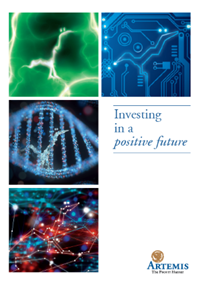Six ways to identify a positive-impact investment
When analysing companies, Artemis’ impact equities team ask six key questions. They explain why they need a clear ‘yes’ to them all before investing.
Being able to provide a clear ‘yes’ in answer to each of the below questions helps us to define a successful, transformative, positive-impact investment. Here we examine the first two of these; this article looks at questions three and four, and questions five and six will follow in a future article.
- Does it have a positive impact?
- Is it radical enough?
- Is its leadership authentic?
- Will it capture value?
- Can we earn a return?
- Are we prepared to be wrong?
Each time we analyse a potential holding, our first question is the same: is it delivering a positive impact? That simple question sometimes results in a more complex answer than you might anticipate. But if the answer isn’t a straightforward ‘yes’, we don’t invest.
Take, for example, treatments for diabetes. In 2019, it caused 4.2 million deaths and approximately 463 million adults worldwide were believed to be living with the disease. That figure is expected to rise to 700 million by 2045. The seventh-biggest killer in the US, it also results in 60% of amputations and 44% of kidney failures. So the positive impact of a company whose products save lives and limbs from this terrible disease might seem to be beyond question…
Take Novo Nordisk. Not only is it the world’s biggest producer of insulin but a majority of its voting shares are controlled by a foundation explicitly committed to supporting scientific, humanitarian and social causes. It duly features in the portfolios of many ‘sustainable’ funds.
There are, however, different ways of managing diabetes, with varying patient experiences, outcomes and costs. The treatments marketed by incumbent operators might not necessarily be those that deliver the optimal outcomes for patients – or for healthcare systems.
Today, the majority of insulin is produced and marketed by a small cartel of dominant producers. Over the past 20 years, its purity has been improved and formulas have been tweaked just enough to maintain patent protection and so prevent competition from generics. Those marginal gains have been used as justification for pushing through (outrageous) inflation-busting price increases, putting healthcare systems under increasing strain.
Introducing Insulet…
Insulet was founded in 2000 with the mission of “improving the lives of people with diabetes”. For us this speaks to its ‘intentionality’; we want to invest in companies that have built their culture around a bold purpose and a laser-like focus on their mission. Its tool for pursuing this mission is the Omnipod, a small, unobtrusive pump patch worn on the body.
A convenient alternative to multiple daily injections and to tubed pumps, which are bulky objects typically carried or worn on the belt, the Omnipod significantly improves the ease of insulin injections and reduces discomfort. It thereby improves patient compliance, especially among children, and so leads to better outcomes. Fewer hypoglycaemic events, in turn, means lower costs for healthcare providers.
Reducing ‘whole system’ healthcare costs
On average, someone with diabetes will have 35.1 non-severe and 2.5 severe hypo events per year. The costs this imposes on the US healthcare system and economy are estimated to be around $11.4bn per year. Here we see evidence of ‘materiality’. The size of the problem will determine the absolute impact a particular company can have. Diabetes is clearly a problem that needs to be addressed.
Each Omnipod costs $20-30 for a three-day patch, which is equivalent to an ongoing cost of $2,400-$3,700 per annum. Clearly, this isn’t cheap. Yet while the direct costs of the Omnipod may exceed those of needle injections of insulin, the up-front capital costs are far lower than they are for tubed pumps. And, in contrast to tubed-pump devices, the Omnipod is, in effect, a pay-as-you-go solution. There is no up-front capital cost which means the barriers to its adoption are much lower.
Moreover, the Omnipod 5 system, which combines Insulet’s patch with a continuous glucose monitor made by Dexcom, in effect, creates an ‘artificial pancreas’, supplying insulin when it is needed and in the right doses. This increases a diabetic’s ‘time in glucose range’ from 40-50% to more than 75%. This means episodes of severe and non-severe hypoglycaemia are less frequent. Moreover, the painful, pernicious and costly long-term effects associated with diabetes – such as kidney failure, heart disease hypertension and amputation – are reduced.
So while the subscription price for Omnipod may be higher than for directly injected insulin, it provides dramatically better patient outcomes and so lowers ‘whole system’ costs.
The dividends of disruption
If healthcare systems are to meet the needs of their ageing populations, it is clear that systemic shifts are needed. History teaches us that incumbent industries – including in the healthcare sector – tend to resist change. As a result change takes place incrementally – if it happens at all. So we seek to invest in companies that can deliver transformational positive change and avoid those clinging to the profits they made in the past.
We believe Insulet has the potential to reconfigure an industry with a profitable but questionable history of pushing through inflation-busting price rises over the past two decades. In addition to improving the lives of diabetics, we think it has the potential to vertically integrate insulin delivery (through pre-loaded pumps) at a much cheaper rate than traditional (price gouging) suppliers of insulin pumps or pens. Here we see potential for ‘additionality’; we believe transformation happens through disruptive innovation and not through incremental improvements to the status quo.
Diabetes is of material significance to the world. Creating better – and cheaper – technologies for mitigating its impact, on people and on healthcare systems, is imperative. So while Insulet makes it past this first test – and into our portfolio – Novo Nordisk does not.
We see ourselves as unorthodox investors. The world is well supplied with funds investing in large and mega-cap businesses that exhibit traditional ‘quality’ characteristics. Most ‘sustainable’ funds are no different. But our work suggests that incumbent companies – almost by definition – tend to favour the status quo over change.
So we seek radical businesses. By this, we mean enablers of transformational, systemic change. Radicalism, of course, takes different shapes. Sometimes it is obvious: think of the ranks of Tesla Superchargers springing up across the developed world
In other instances, however, a technology can be all but invisible – yet still deliver a radically better outcome than any of its predecessors or rivals.
Mips’ products fall into the latter category. Millions of its units have already been sold. In fact, you may own one already without knowing it. Although it is not (yet) a consumer brand like Adidas, Mips’ intention is to become the Gore-Tex of safety helmets by building awareness of its brand (a yellow circle now denotes products containing its technology).
Quietly radical
In contrast to majority of products sold by the major sportswear brands (tracksuits to accommodate the expanding waists of homeworkers; limited-edition trainers designed to be Instagrammed and traded like baseball cards), Mips’ technology has a meaningful and measurable impact, saving human lives and – here’s the radical bit – by making sustainable modes of transportation such as cycling far safer. How?
Mips designs ‘Multi-directional Impact Protection Systems’. These ‘slip planes’ are, in effect, interior layers fitted inside helmets. They allow for 10-15 mm of rotational movement between the head and the helmet in the critical milliseconds after an impact. This reduces the rotational forces exerted on the brain in the event of a crash and so reduces brain injuries relative to the same helmet without Mips fitted.
That its brand is less well-known than, say, Adidas is largely because it works as a supplier of components, selling its technology to 60 global helmet brands. Its slip planes are already found in helmets for cyclists (its biggest market) but also for skiers, horse riders, rock climbers, ice hockey players and motorcyclists. It is now expanding into potentially huge market for ‘type II’ safety helmets used in industrial settings and by the police.
What makes MIPS different?
In every company we consider for the portfolio, we want to see evidence of ‘intentionality’. In other words, the mission or objectives of the business must be directly aligned to positive impact. Before creating Mips, its founders – a group of Swedish scientists – spent years studying the relationship between brain injuries and helmet construction. In fact, Peter Halldin, one of the founders, is still its chief science officer today.
Their studies, carried out in purpose-built lab near Stockholm, showed that existing helmet technologies do a good job of reducing the energy – and so protecting the brain – in the event of a straight, linear impact. But here’s the problem: the most common type of impact from crashes or falls is actually an oblique or angled impact.
And whereas a linear motion of the head can cause a skull fracture or contusion, rotational motion triggered by an angled impact may also cause injuries such as concussions, subdural hematoma (bleeding between the brain and the skull) or diffuse axonal injury (when the brain shifts rapidly in the skull).
Does it work?
Mips asks the companies it works with to submit sample helmets for testing and analysis before it licenses its technology. Although litigation risk prevents the company from stating helmets are 'the safest’, its testing can demonstrate that a helmet featuring Mips is significantly better at dissipating rotational impacts than the non-Mips alternative. In some cases, the company suggests the actual reduction in strain can be as high as 40%.
There are, then, different ways to be radical. Helping to reduce deaths and injuries from road accidents and protecting commuters using more sustainable forms of transport is a subtly radical way of challenging the unsustainable status quo. So on this basis Mips makes it past this second test – and into our portfolio. Adidas, for all the power of its consumer brand and the incredible popularity of its Yeezys, does not.
A detailed look...
Everything you need to know about the impact investment team’s philosophy, process and approach.





